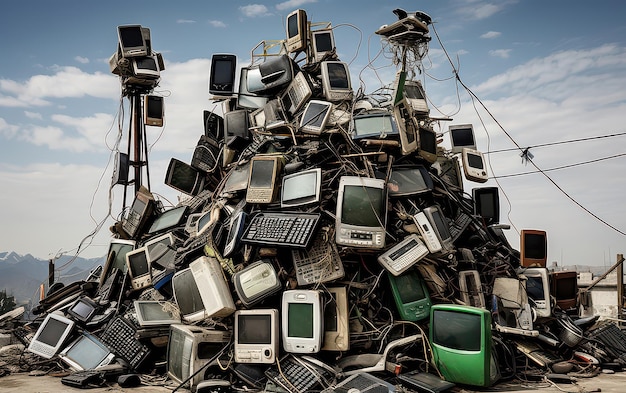E-Waste: Environmental Impact & US Solutions

The escalating volume of e-waste poses significant environmental challenges due to hazardous materials, but the US is implementing multifaceted strategies, including legislation and recycling initiatives, to mitigate these impacts and promote sustainable technology management.
In our increasingly digital world, electronic devices have become indispensable, yet their rapid obsolescence creates a growing crisis: e-waste. Understanding what are the environmental impacts of e-waste and how is the US addressing the problem is crucial for a sustainable future.
The Hidden Dangers: Environmental Impacts of E-Waste
Electronic waste, or e-waste, refers to discarded electrical or electronic devices. As technology advances at an unprecedented pace, the lifecycle of gadgets shortens, leading to an increasing accumulation of these discarded items. However, beyond the sheer volume, it’s the toxic composition of e-waste that presents a profound environmental threat, impacting ecosystems and human health on a global scale. This section delves into the specific ways e-waste can wreak havoc on our planet.
Soil and Water Contamination: A Toxic Legacy
When electronic devices are improperly disposed of in landfills, their hazardous components can leach into the surrounding environment. This process is particularly concerning for soil and water systems. Heavy metals like lead, mercury, cadmium, and beryllium, along with other dangerous chemicals such as brominated flame retardants (BFRs), are commonly found in electronic goods. Over time, rain and decomposition can cause these substances to seep from the waste, contaminating the soil and subsequently, groundwater and surface water. This pervasive pollution can render agricultural lands infertile and make water sources unsafe for consumption, affecting both human populations and wildlife.
- Lead: Commonly found in Cathode Ray Tubes (CRTs) of older monitors and televisions, lead can cause neurological damage and reproductive issues.
- Mercury: Present in LCD screens, batteries, and fluorescent lamps, mercury is a potent neurotoxin that bioaccumulates in food chains.
- Cadmium: Used in chip resistors and semiconductors, cadmium can damage kidneys, bones, and the respiratory system.
The long-term effects of such contamination are daunting. These toxins persist in the environment for extended periods, entering the food chain and eventually accumulating in plants, animals, and humans. The implications for biodiversity are severe, as aquatic life and terrestrial ecosystems can be irrevocably harmed by the persistent presence of these hazardous materials. Addressing this contamination necessitates meticulous waste management and the prohibition of improper disposal methods.
Atmospheric Pollution: The Invisible Threat
Beyond soil and water, e-waste also contributes significantly to air pollution, primarily through two pathways: the informal recycling sector and the incineration of electronic components. In many developing countries, informal e-waste recycling operations are prevalent, where workers, often without protective gear, dismantle and process electronics using rudimentary methods. This often involves open burning of plastic components to extract valuable metals like copper. This practice releases a cocktail of highly toxic chemicals, including dioxins, furans, polycyclic aromatic hydrocarbons (PAHs), and heavy metals, into the atmosphere. These airborne pollutants can travel long distances, dispersing over wide areas and affecting air quality far from the original source.
Similarly, the incineration of e-waste, even in controlled facilities, can lead to the emission of harmful gases and particulate matter. While modern incinerators may have emission controls, the complex chemical composition of electronics means that complete combustion without toxic byproducts is challenging. These atmospheric pollutants contribute to various respiratory diseases, cardiovascular problems, and even developmental issues in humans. Furthermore, some of these chemicals are greenhouse gases, contributing to climate change and global warming. The invisible threat of atmospheric pollution from e-waste underscores the need for safe and regulated recycling processes globally.

Resource Depletion and Energy Consumption: A Strain on the Planet
The manufacturing process for electronic devices is incredibly resource-intensive, requiring significant amounts of raw materials and energy. Many of these materials are finite, including precious metals like gold, silver, and platinum, along with critical rare-earth elements. The constant demand for new gadgets means continuous mining of these materials, leading to deforestation, habitat destruction, and significant carbon emissions from extraction and processing activities. The rapid turnover of electronic products, where older models are quickly replaced by newer ones, exacerbates this problem, creating a linear “take-make-dispose” economy that is inherently unsustainable.
The Energy Footprint of Production and Disposal
Every stage of an electronic device’s life cycle – from mining raw materials to manufacturing, transportation, and eventual disposal – consumes vast amounts of energy. The production of a single computer, for instance, requires significant water, fossil fuels, and chemicals. When devices are discarded prematurely, the energy invested in their creation is essentially wasted, increasing the overall energy footprint of the electronics industry. Moreover, improper disposal methods, such as landfilling or informal burning, offer no opportunity to recover valuable materials, meaning new raw materials must be extracted again for future production, perpetuating the cycle of consumption and depletion.
Recycling, when done properly, can significantly reduce the need for virgin materials and save energy. Extracting metals from e-waste can be far less energy-intensive than mining them from the earth. Therefore, a robust e-waste management system is not just about preventing pollution, but also about conserving finite resources and reducing energy consumption, moving towards a more circular economy where materials are reused and recycled endlessly.
Public Health Implications: A Direct Threat to Communities
The environmental impacts of e-waste are not abstract; they translate directly into tangible public health crises, particularly for communities living near informal e-waste dumps or processing sites. Exposure to the toxins released from e-waste can lead to a wide range of debilitating health problems. Children are particularly vulnerable due to their developing bodies and higher rates of exposure.
Specific Health Concerns Linked to E-Waste Exposure
The hazardous substances in e-waste can affect almost every organ system. For instance, lead exposure, common in e-waste processing, is known to cause severe neurological damage, developmental delays in children, and kidney dysfunction. Mercury can impair brain function, damage kidneys, and affect the nervous system. Cadmium exposure can lead to kidney disease, bone damage, and respiratory problems. Additionally, brominated flame retardants (BFRs), used in plastics and circuit boards, are persistent organic pollutants that can disrupt endocrine functions and potentially cause cancer. These chemicals can be inhaled, ingested through contaminated food or water, or absorbed through skin contact.
- Neurological Issues: Lead and mercury can cause significant damage to the brain and nervous system.
- Respiratory Illnesses: Inhalation of airborne particulates and toxic gases leads to asthma, bronchitis, and other respiratory disorders.
- Reproductive Problems: Exposure to various toxins can affect fertility and cause birth defects.
- Cancer: Certain chemicals released from e-waste are known carcinogens.
The indirect health impacts are also significant, as environmental contamination can lead to diminished agricultural yields, unsafe drinking water, and reduced fishing resources, affecting food security and livelihoods. Protecting public health from e-waste requires not only stricter regulations on disposal and recycling but also public awareness campaigns to ensure safe handling and proper disposal practices among consumers.
How the US Is Addressing the E-Waste Problem: A Multi-faceted Approach
Recognizing the multifaceted challenges posed by e-waste, the United States has adopted a combination of legislative, industrial, and grassroots initiatives to address the problem. While there isn’t a single federal law governing e-waste across all states, the approach is characterized by a patchwork of state-level regulations, industry voluntary programs, and consumer awareness campaigns. The goal is to shift from a linear “take-make-dispose” model to a more circular economy where electronics are reused, repaired, and recycled, minimizing their environmental footprint.
Legislation and Regulation: State-Level Dynamics
Unlike some other countries, the US does not have a federal law for e-waste management, leading to a varied regulatory landscape across states. Currently, over 25 states have enacted e-waste recycling laws. These laws typically fall into one of two categories:
- Producer Responsibility Laws: These laws (e.g., in California, New York, Washington) place the primary responsibility for funding and managing e-waste recycling on electronics manufacturers. Manufacturers are often required to register with the state, meet collection targets, and finance recycling programs. This incentivizes them to design more recyclable products and consider end-of-life management.
- Consumer Responsibility Laws: Fewer states have these, but they might involve a ban on disposing of electronics in landfills or require consumers to pay a small fee at the point of purchase to support recycling infrastructure.
The fragmented nature of these laws can create complexities for manufacturers operating nationwide, but it also allows states to tailor solutions to their specific needs and capacities. The presence of these state laws has significantly increased the volume of e-waste properly collected and recycled, diverting hazardous materials from landfills and promoting safer processing practices. Enforcement and consistent implementation across states remain ongoing challenges.
Recycling Infrastructure and Industry Initiatives: Building a Circular Economy
Beyond legislation, a robust recycling infrastructure is crucial for effective e-waste management. The US has seen significant growth in certified e-waste recyclers. Organizations like the Responsible Recycling (R2) certification and e-Stewards certification provide rigorous standards for electronics recyclers, ensuring that they follow environmentally sound management practices, protect worker health and safety, and do not illegally export hazardous materials to developing countries. These certifications are vital in preventing “toxic dumping” masquerading as recycling. Many major electronics manufacturers also participate in voluntary take-back programs, offering consumers convenient ways to return old devices for recycling or refurbishment. These programs are often a result of corporate social responsibility initiatives or in response to growing consumer demand for sustainable practices. The push towards a circular economy in electronics entails not only recycling but also emphasizes repairing, reusing, and refurbishing devices to extend their lifespan and reduce the need for new production. This includes supporting initiatives like the “right to repair” movement, which aims to make it easier for consumers to fix their own devices or have them repaired by independent shops.

Consumer Awareness and Participation: The Role of the Individual
Ultimately, the success of e-waste management largely depends on consumer awareness and participation. Many individuals are unaware of the proper disposal methods for their old electronics or the environmental dangers posed by improper disposal. Educational campaigns by government agencies, non-profits, and industry associations play a vital role in informing the public about the importance of e-waste recycling, where to find drop-off locations, and how to safely prepare devices for recycling (e.g., wiping data). Community recycling events, often organized by local governments or non-profits, provide accessible opportunities for residents to dispose of e-waste responsibly. Retailers also play a role by partnering with certified recyclers or offering in-store take-back programs for certain products. The shift in consumer behavior, driven by increased awareness and convenient recycling options, is fundamental to closing the loop on electronic waste and mitigating its environmental impact. It emphasizes that while manufacturers and governments have significant roles, individual actions collectively form a powerful force in addressing this global challenge.
| Key Point | Brief Description |
|---|---|
| 🌍 Toxic Contamination | E-waste releases heavy metals and hazardous chemicals into soil, water, and air, leading to widespread environmental pollution. |
| 🧑🤝🧑 Public Health Risk | Exposure to e-waste toxins can cause severe neurological, respiratory, and reproductive health issues in humans, especially children. |
| 🔄 US Solutions | The US employs state-level legislation, certified recycling programs, and consumer awareness to combat e-waste. |
| 💡 Circular Economy | Efforts focus on promoting reuse, repair, and proper recycling to conserve resources and reduce the environmental footprint. |
Frequently Asked Questions About E-Waste
▼
E-waste, or electronic waste, refers to discarded electrical or electronic devices, including everything from old cell phones and laptops to refrigerators and televisions. It comprises components, sub-assemblies, and consumables that are no longer useful and are intended for disposal, often due to technological obsolescence or damage.
▼
E-waste contains a complex mix of hazardous materials like lead, mercury, cadmium, and brominated flame retardants. When improperly disposed of, these toxins can leach into soil and water, contaminating ecosystems, and releasing harmful gases into the air if burned, posing serious threats to environmental health.
▼
Exposure to toxins released from e-waste can cause a range of severe health problems. These include neurological damage, kidney disease, respiratory illnesses, reproductive system dysfunction, and even cancer. Children are particularly susceptible to these health impacts due to their developing bodies and higher exposure rates.
▼
The US addresses e-waste through a combination of state-level legislation, promoting certified recycling programs, and fostering consumer awareness. Many states have “producer responsibility” laws that require manufacturers to manage recycling, while certified recyclers ensure environmentally sound practices. Public campaigns also encourage proper disposal.
▼
To properly dispose of e-waste, check your local municipal waste management website for designated drop-off points or special collection events. Many electronics retailers also offer take-back programs for old devices. Certified e-waste recyclers (R2 or e-Stewards certified) are also excellent options for environmentally responsible disposal.
Conclusion
The rising tide of electronic waste presents a formidable challenge to global environmental sustainability and public health. From contaminating our precious soil and water resources with toxic heavy metals to polluting the atmosphere through hazardous informal recycling practices, the environmental impacts of e-waste are profound and far-reaching. Furthermore, the relentless demand for new electronics exacerbates resource depletion and consumes vast amounts of energy, highlighting the unsustainable nature of our current linear consumption model. However, the multifaceted approach taken by the United States, involving a blend of state-level legislation, the development of certified recycling infrastructure, and increasingly robust consumer awareness campaigns, offers a blueprint for progress. While the absence of a single federal law creates complexities, the collective efforts across states, industries, and individual consumers are gradually shifting towards a more circular economy. This paradigm emphasizes not just recycling, but also the crucial roles of reuse, repair, and refurbishment in extending the lifespan of devices and minimizing their ecological footprint. Ultimately, mitigating the enduring effects of e-waste requires sustained innovation, stringent regulatory oversight, and a collective commitment from every stakeholder in the technology lifecycle to ensure a healthier planet for generations to come.





